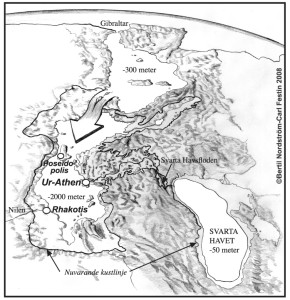basileia
Basileia (L)
Basileia is defined in dictionaries as an ancient Greek word denoting ‘citadel’ or ‘royal palace’. However, Plato used both the Greek word ‘basileia’ as well as ‘metropolis’ in Critias 115c. Metropolis originally meant ‘mother city’ and in time became a generic term applicable to any seat of power. It is widely used in the New Testament with the meaning of ‘kingdom (of god)’.
Some commentators have used Basileia when referring to the entire capital city of Atlantis, while Jürgen Spanuth arbitrarily went further using Basileia as the name of the whole capital island, which he identifies as Heligoland. He also equates Basileia with Asgard, the home of the gods in Norse mythology. His views were echoed by others such as Walter Baucum.
When you combine that with Plato’s statement that names given to Solon were translated into their Greek equivalents and so we can safely conclude that Basileia, like Atlantis, was not an original placename.
Festin, Carl
Carl Festin (1957- ) is a Swedish researcher who was prompted by questions from his children to investigate the history of civilisation. His studies led him to conclude that the hundreds of worldwide flood myths involved a catastrophe that involved the biblical story of Noah* and Plato’s  tale of Atlantis.
tale of Atlantis.
In a PowerPoint presentation provocatively entitled Noah, Refugee from Atlantis Festin outlines a new Atlantis theory. He first suggests that a ridge of sediment built up in the vicinity of Gibraltar gradually cutting off the Mediterranean from the Atlantic when sea levels were much lower during the last Ice Age. This similar in some ways with the theory of Paulino Zamarro.
Festin posits an island in the Eastern Mediterranean, south of Crete, called Basileia, which dominated land around what we now call the Ionian Sea. This nation was known as Atlantis.
He identifies the mountains of what is now Crete and Al Jabal Al Akhdar (Green Mountain) in Libya as the Pillars of Heracles. These are shown on a new map(b). Other maps(c) show his proposed Atlantean capital, Poseidopolis and are sometimes oriented east-west.
Around 3,500 BC the Gibraltar ridge broke due to the pressure of the rising ocean levels following the melting of the ice. The influx of cold water into the Western Mediterranean Basin created extensive anti-cyclonic rainfall over Basileia (40 days and nights!). The Western and Eastern Mediterranean Basins were separated by a landbridge at the Strait of Sicily which now broke, inundating the eastern basin. Festin claims that the millions of tons of additional  water created earthquakes in seismically fragile central Mediterranean, destroying Basileia. Survivors included Noah who headed eastward. Others reached both North and South America.
water created earthquakes in seismically fragile central Mediterranean, destroying Basileia. Survivors included Noah who headed eastward. Others reached both North and South America.
Festin is now organising a five day cruise in the Mediterranean, which will include a dive in a small submersible to the Atlantean capital Poseidopolis on the submerged island of Basileia lying between Crete and Cyrenaica in Libya. The adventure can be watched on board the ship on large screens, while for the really enthusiastic, there are 8/10 spaces available in the submarine. He currently estimates the basic cost to be €2,000 and €100,000 for each of the 8/10 submariners(d). I think comment is unnecessary!
His theories are published in Swedish as Flykting från Atlantis[753] (Refugees from Atlantis)(a).
(b) http://www.resmalet.se/Atlantis.htm
Spanuth, Dr Jürgen
 Dr Jürgen Spanuth (1907-1998) was born in Austria and studied theology and archaeology at university. He became the pastor of Bordelum in Northern Germany.
Dr Jürgen Spanuth (1907-1998) was born in Austria and studied theology and archaeology at university. He became the pastor of Bordelum in Northern Germany.
According to Life magazine of Sept. 8, 1952(g), after twenty years of research, he organised a dive around Heligoland and found extensive underwater structures. These explorations led to his book Das Entraselte Atlantis [0016] being published in 1953. It was later translated into English and published as Atlantis of the North [0015] and is now available to read on the internet(a).
Spanuth’s basic thesis was that following a major catastrophe in the North Sea around 1250 BC, the Mediterranean experienced an invasion of Scandinavians, whom he referred to as the ‘North Sea Peoples’. Part of the physical evidence he produced was the horn-helmeted Sea Peoples depicted at Medinet Habu. Since we are all used to seeing Vikings depicted with horned helmets, many are surprised to find that it is a late 19th-century invention(e)(f).
Spanuth’s theory implies that such helmets had been a standard army issue in the region for over a millennium. In fact, the Vikings used rather plain helmets which they did not manufacture themselves but traded for them from other Germanic peoples in mainland Europe(d). On the other hand, one of the Sea Peoples, the Shardana, generally believed to have come from Sardinia, did use horned-helmets. However, there are aspects of this claim that are the subject of continuing debate, but the suggestion of a North Sea connection has weakened considerably.
Spanuth considered Basileia, the royal island of Atlantis, to have been located near Heligoland. He produced a mass of evidence to support his views but found his book under severe attack by many academics, which, in general, had the support of the public. After being publicly labelled, among other things, a liar, Spanuth was forced to challenge his detractors in the courts. After some six years, he was vindicated when ten professors withdrew their plea, admitting that their arguments against the pastor were untenable. Felix R. Paturi has more information[1339.215] on this disgraceful episode, as well as a note of scientists who supported Spanuth.
>The late Bernhard Beier expanded on the list of academics who did endorse Spanuth(i)(j) and in some ways more interesting is an article he wrote giving an account of the efforts of many academics to silence Spanuth completely. Coincidentally, around the same time, Immanuel Velikovsky was under a similar attack in the USA.<
A study of Spanuth’s references would suggest that he had access to the prehistoric research archives of the Ahnenerbe and has successfully collated and analysed a lot of this extensive material in his books. Vidal-Naquet bluntly labels him a Nazi[580.124], although his publisher, Wolfram Zeller, denied it. It may be relevant to mention that in the 1930s, Heinrich Pudor an avowed German anti-Semite also proposed Helgoland as Atlantis, but I have been unable to find any reference to Pudor by Spanuth!
The German Wikipedia claims that Spanuth was a member of the NSDAP (Nazi Party) from 1933 until 1945. Similar claims that he had been in the SS have also been refuted(c). In 2002, Frank Doenenburg, on his website(b) discussed Spanuth’s politics at length. In my view, all these matters, however unsavoury, risk distracting us today from discussing dispassionately the merits or otherwise of Spanuth’s Atlantis theories.
Spanuth’s second book[017] had a much better reception. His final offering was Die Atlanter(1976), which was also published in English[015], however, this is just a revised and expanded version of his 1965 book[048].
Atlantisforschung has highlighted Spanuth’s opposition to the Minoan Hypothesis in a discussion paper on its website. I have published here a translation of a short excerpt from Die Atlanter that shows his disdain for the idea of an Aegean Atlantis.
“Neither Thera nor Crete lay in the ‘Atlantic Sea’, but in the Aegean Sea, which is expressly mentioned in Crit. 111a and contrasted with the Atlantic Sea. Neither of the islands lay at the mouth of great rivers, nor did they “sink into the sea and disappear from sight.” ( Tim. 25d) The Aegean Sea never became “impassable and unsearchable because of the very shallow mud”. Neither Solon nor Plato could have said of the Aegean Sea that it was ‘still impassable and unsearchable’
or that ‘even today … an impenetrable and muddy shoal’ ‘blocks the way to the opposite sea’ ( Crit. 108e). Both had often sailed the Aegean Sea, and their contemporaries would have laughed at them for telling such follies.”(h)
Spanuth has still a lot of supporters and is constantly referred to, particularly by German investigators such as Arn Strohmeyer[557] and Gerhard Herm[382]. Felice Vinci, who strongly favours a Northern European origin for Homer’s epic tales, also places Atlantis in a northern context. The Danish writer, Kirsten Bang, published a short book [679] in which she also placed Atlantis in the Wadden Sea where Helgoland is located. She also supports a date of 1300 BC for its destruction.
Another recent supporter of Spanuth’s Atlantis theory is Holger Kalweit who has written a trilogy, the first of which is Irrstern über Atlantis [1024]. This initial volume is concerned with the destruction of Atlantis by a comet (Phaeton) in 1222 BC, leaving Helgoland as a remnant. Refugees fled south to the Eastern Mediterranean leaving their cultural imprint on the region. Unfortunately. this huge 700-page book is to be followed by two more in which the author moves on to expand on the subject of ‘lizard people’, which for me has him as a fully paid-up member of the lunatic fringe.
(a) https://archive.org/details/atlantisofnorth00span/mode/2up Read Only
(b) https://www.fdoernenburg.de/Forum/viewtopic.php?f=28&t=1213 (page closed, July 2017)
(d) https://www.quora.com/Where-did-the-myth-about-the-Vikings-having-horned-helmets-originate
(h) Jürgen Spanuth über ‘Atlantis in der Ägäis’ – Atlantisforschung.de
(i) An “illustrious society” – Atlantisforschung.de (atlantisforschung-de.translate.goog) *
(j) An “illustrious society” (II) – Atlantisforschung.de (atlantisforschung-de.translate.goog) *
